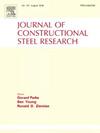Study on static mechanical behavior of spatial cable supported composite floor system
IF 4
2区 工程技术
Q1 CONSTRUCTION & BUILDING TECHNOLOGY
引用次数: 0
Abstract
As modern society rapidly evolves, traditional large-span floor structures increasingly fail to meet the demands of modern large-span spaces. This study introduces an innovative spatial cable supported composite floor system. Field tests and finite element analyses, accounting for the construction process, were conducted to evaluate the overall deformation capacity, bearing capacity, and key parameter influences of the structure under vertical static loads. Test results reveal that when the load reaches 1.4 times the basic combined load, the mid-span deflection is 5.03 mm—just one-third of the allowable value specified in the code—demonstrating the excellent bearing performance of the spatial cable-supported composite floor. Finite element simulation results indicate that the construction process impacts the floor's bearing performance. The inclusion of the cable-strut system significantly enhances the floor's ultimate bearing capacity and allows for coordinated deformation with the upper structure. Compared to a conventional primary and secondary beam floor, the composite floor's bearing capacity increases by 22 %. The inner and outer cable-strut systems serve distinct roles and exhibit spatial force transmission characteristics.
求助全文
约1分钟内获得全文
求助全文
来源期刊

Journal of Constructional Steel Research
工程技术-工程:土木
CiteScore
7.90
自引率
19.50%
发文量
550
审稿时长
46 days
期刊介绍:
The Journal of Constructional Steel Research provides an international forum for the presentation and discussion of the latest developments in structural steel research and their applications. It is aimed not only at researchers but also at those likely to be most affected by research results, i.e. designers and fabricators. Original papers of a high standard dealing with all aspects of steel research including theoretical and experimental research on elements, assemblages, connection and material properties are considered for publication.
 求助内容:
求助内容: 应助结果提醒方式:
应助结果提醒方式:


